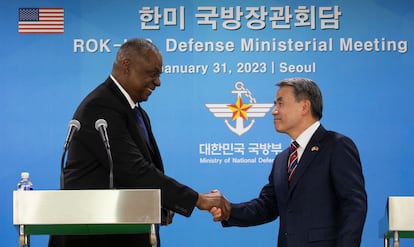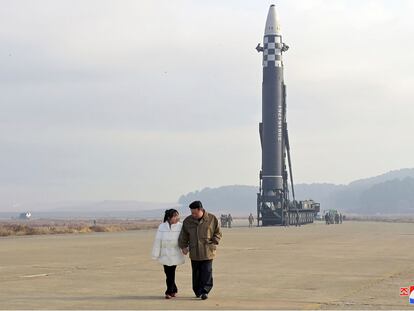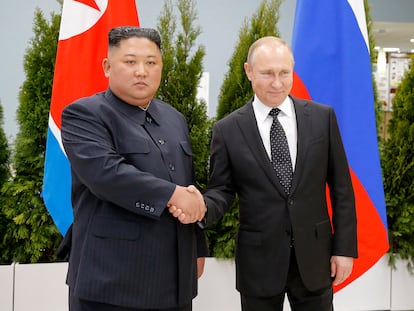US to increase weapons deployment to counter North Korea
South Korea and the United States have also been strengthening their security cooperation with Japan

US Defense Secretary Lloyd Austin on Tuesday said the United States will increase its deployment of advanced weapons such as fighter jets and bombers to the Korean Peninsula as it strengthens joint training and operational planning with South Korea in response to a growing North Korean nuclear threat.
Austin made the comments in Seoul after he and South Korean Defense Minister Lee Jong-Sup agreed to further expand their combined military exercises, including a resumption of live-fire demonstrations, and continue a “timely and coordinated” deployment of US strategic assets to the region, according to their offices.
Austin and Lee also discussed preparations for a simulated exercise between the allies in February aimed at sharpening their response if North Korea uses nuclear weapons.
Austin’s trip comes as South Korea seeks stronger assurances that the United States will swiftly and decisively use its nuclear capabilities to protect its ally in face of a North Korean nuclear attack.
South Korea’s security jitters have risen since North Korea test-fired dozens of missiles in 2022, including potentially nuclear-capable ones designed to strike targets in South Korea and the US mainland.
South Korea and the United States have also been strengthening their security cooperation with Japan, which has included trilateral missile defense and anti-submarine warfare exercises in past months amid the provocative run in North Korean weapons tests.
In a joint news conference following their meeting, Austin and Lee said they agreed that their countries’ resumption of large-scale military drills last year, including an aerial exercise involving US strategic bombers in November, effectively demonstrated their combined capabilities to deter North Korean aggression.
The allies had downsized their training in recent years to create room for diplomacy with North Korea during the Trump administration and because of the COVID-19 pandemic.
“We deployed fifth-generation aircraft, F-22s and F-35s, we deployed a carrier strike group to visit the peninsula, you can look for more of that kind of activity going forward,” Austin said.
He said the US commitment to protecting its allies with its full range of military capabilities, including nuclear ones, remains “ironclad.”
North Korea’s ramped-up missile tests have been punctuated by threats to preemptively use its nuclear weapons in a broad range of scenarios in which it perceives its leadership to be under threat, including conventional clashes or non-war situations.
Tensions could further rise in coming months, with North Korean leader Kim Jong-un doubling down on his nuclear ambitions.
During a political conference in December, Kim called for an “exponential increase” in nuclear warheads, mass production of battlefield tactical nuclear weapons targeting South Korea, and development of more powerful long-range missiles designed to reach the US mainland.
Experts say Kim’s nuclear push is aimed at forcing the United States to accept the idea of North Korea as a nuclear power and negotiating badly needed economic concessions from a position of strength.
Nuclear negotiations between the US and North Korea have been derailed since 2019 because of disagreements over a relaxation of US-led economic sanctions against the North in exchange for steps by North Korea to wind down its nuclear weapons and missiles programs.
North Korea’s growing nuclear arsenal and provocations have raised the urgency for South Korea and Japan to strengthen their defense postures in line with their alliances with the United States.
In an interview with The Associated Press this month, South Korean President Yoon Suk Yeol said his government was discussing with the Biden administration joint military planning potentially involving US nuclear assets.
In December, Japan made a major break from its strictly self-defense-only post-World War II principle, adopting a new national security strategy that includes the goals of acquiring preemptive strike capabilities and cruise missiles to counter growing threats from North Korea, China and Russia.
Sign up for our weekly newsletter to get more English-language news coverage from EL PAÍS USA Edition
Tu suscripción se está usando en otro dispositivo
¿Quieres añadir otro usuario a tu suscripción?
Si continúas leyendo en este dispositivo, no se podrá leer en el otro.
FlechaTu suscripción se está usando en otro dispositivo y solo puedes acceder a EL PAÍS desde un dispositivo a la vez.
Si quieres compartir tu cuenta, cambia tu suscripción a la modalidad Premium, así podrás añadir otro usuario. Cada uno accederá con su propia cuenta de email, lo que os permitirá personalizar vuestra experiencia en EL PAÍS.
¿Tienes una suscripción de empresa? Accede aquí para contratar más cuentas.
En el caso de no saber quién está usando tu cuenta, te recomendamos cambiar tu contraseña aquí.
Si decides continuar compartiendo tu cuenta, este mensaje se mostrará en tu dispositivo y en el de la otra persona que está usando tu cuenta de forma indefinida, afectando a tu experiencia de lectura. Puedes consultar aquí los términos y condiciones de la suscripción digital.
More information
Archived In
Últimas noticias
There is as much life left to discover on planet Earth as that which is already known
Dozens presumed dead, around 100 injured in fire at Swiss Alps bar during New Year’s celebration
Is porn for women different from conventional porn? We spoke to those who make it
Cartagena de Indias is sinking: What can the city do to mitigate it?
Most viewed
- Reinhard Genzel, Nobel laureate in physics: ‘One-minute videos will never give you the truth’
- David King, chemist: ‘There are scientists studying how to cool the planet; nobody should stop these experiments from happening’
- Oona Chaplin: ‘I told James Cameron that I was living in a treehouse and starting a permaculture project with a friend’
- Sinaloa Cartel war is taking its toll on Los Chapitos
- The Interoceanic Train, the Mexican alternative to the Panama Canal










































